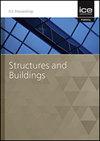Vulnerability analysis on a dataset of long-span timber structures in Italy
IF 1.4
4区 工程技术
Q3 CONSTRUCTION & BUILDING TECHNOLOGY
Proceedings of the Institution of Civil Engineers-Structures and Buildings
Pub Date : 2023-02-22
DOI:10.1680/jstbu.21.00200
引用次数: 0
Abstract
Long-span structures, such as school gyms and sports centres, are often used by the Italian Department of Civil Protection (DPC) as post-catastrophe shelters or headquarters. The Emilia 2012 earthquake drew the attention of the DPC to this type of structure due to the damage that many of these buildings suffered. In this paper, a dataset of 101 timber structures was analysed based on a simplified methodology that detects the major vulnerabilities in long-span timber roofs to help planning further investigations and retrofit interventions. The methodology analyses the elements most vulnerable to the seismic action quantitatively and qualitatively, with fast and straightforward approaches. The quantitative evaluation of the vulnerabilities was achieved by applying the Italian Building Code. The aspects not considered in the quantitative evaluation were instead assessed through qualitative parameters inspired by damage identification forms, such as the AeDES form. The structures analysed are located near the epicentres of the last strong earthquakes that struck Italian territory: Abruzzo 2009, Emilia 2012, and central Italy 2016. Damage and retrofits, identified by interviewing owners, designers, and builders, showed a good correlation between the real behaviour shown by the surveyed structures and the vulnerabilities detected by the simplified methodology.意大利大跨度木结构数据集脆弱性分析
大跨度结构,如学校体育馆和体育中心,经常被意大利民防部门(DPC)用作灾后避难所或总部。2012年的艾米利亚地震引起了DPC对这类建筑的关注,因为这些建筑中有许多遭受了破坏。在本文中,基于一种简化的方法分析了101个木结构的数据集,该方法检测了大跨度木屋顶的主要脆弱性,以帮助规划进一步的调查和改造干预措施。该方法定量和定性地分析了最易受地震作用影响的要素,方法简单快捷。脆弱性的定量评估是通过应用意大利建筑规范来实现的。定量评价中未考虑的方面通过损伤识别表(如AeDES表)启发的定性参数进行评估。分析的结构位于最近一次袭击意大利领土的强烈地震的震中附近:2009年的Abruzzo, 2012年的Emilia和2016年的意大利中部。通过采访业主、设计师和建筑商确定的损坏和改造,显示了被调查结构所显示的真实行为与简化方法检测到的漏洞之间的良好相关性。
本文章由计算机程序翻译,如有差异,请以英文原文为准。
求助全文
约1分钟内获得全文
求助全文
来源期刊
CiteScore
3.40
自引率
6.20%
发文量
61
审稿时长
12 months
期刊介绍:
Structures and Buildings publishes peer-reviewed papers on the design and construction of civil engineering structures and the applied research associated with such activities. Topics include the design, strength, durability and behaviour of structural components and systems.
Topics covered: energy conservation, people movement within and around buildings, strength and durability of steel and concrete structural components, and the behaviour of building and bridge components and systems

 求助内容:
求助内容: 应助结果提醒方式:
应助结果提醒方式:


